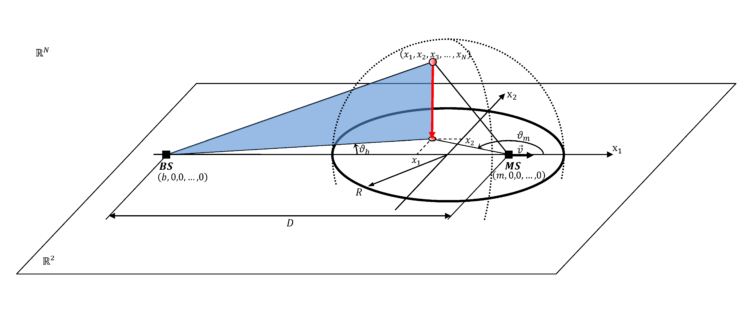A paper published in IEEE Transactions on Wireless Communications
Projective Approach in Determining Homogeneous Hyperspherical Geometrically-based Stochastic Channel Model’s Statistics: Angle of Departure, Angle of Arrival and Time of Arrival
Autori
- Almir Maric
- Odsjek za telekomunikacije, Univerzitet u Sarajevu, Sarajevo, Bosna i Hercegovina
-
- Odsjek za telekomunikacije, Univerzitet u Sarajevu, Sarajevo, Bosna i Hercegovina
-
- Odsjek za telekomunikacije, Univerzitet u Sarajevu, Sarajevo, Bosna i Hercegovina
- Vladimir Lipovac
- Department of Electrical Engineering and Computing, University of Dubrovnik, Dubrovnik, Croatia
Sažetak
This paper proposes geometrically-based stochastic channel model with scatterers homogeneously distributed within N-dimensional (N-D) hyperspherical-shaped scattering region for single-bounce propagation scenario, with arbitrary positions of base station (BS) and mobile station (MS). For such defined geometrically-based stochastic channel model, the angular and temporal statistics are determined by introducing the projective approach. Accordingly, azimuthal angle and time of arrival marginal PDFs are derived in closed form, while the elevation angle PDF can be delivered numerically in general, and in closed-form for specific environmental parameters. The fidelity of the analytically obtained results is evaluated by their comparison to the corresponding normalized histograms. Also, it is shown that the proposed N-D model can be used to analyze some of the existing channel models like 2-D uniform disk and 3-D uniform (hemi)sphere models. Additionally, by introducing the mentioned projective approach, it is shown that the angular statistics of the proposed N-D model are the same as the angular statistics of some nonuniform 2-D and 3-D models, which is an important property of the proposed model. Such observation enabled us, for the first time in the literature, to determinate angular statistics for geometrically-based stochastic channel models such as inverted parabolic scattering model, 2-D Gaussian model and 3-D Gaussian hemisphere model, for arbitrary positions of BS and MS. Such angular characteristics of proposed channel model are validated through several empirical datasets.
Ključne riječi
N-dimensional, homogeneous, Gaussian, inverted parabolic, disk, sphere, hemisphere, geometric model, angle-of-arrival, angle-of-departure, time-of-arrival, single bounce scattering, azimuth, elevation
Citation
A. Maric, E. Kaljic, P. Njemcevic and V. Lipovac, “Projective Approach in Determining Homogeneous Hyperspherical Geometrically-based Stochastic Channel Model’s Statistics: Angle of Departure, Angle of Arrival and Time of Arrival,” in IEEE Transactions on Wireless Communications. doi: 10.1109/TWC.2020.3017154
Naziv časopisa
IEEE Transactions on Wireless Communications
Electronic ISSN
Izdavač
IEEE
Impact Factor
6.779 (2019)





















